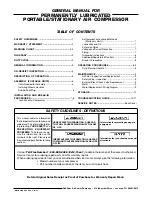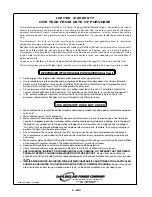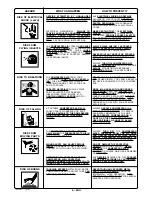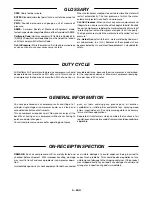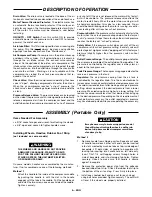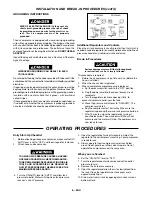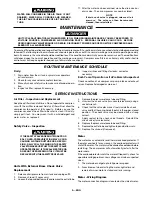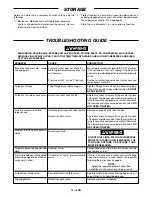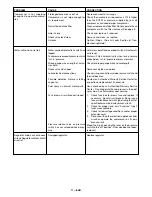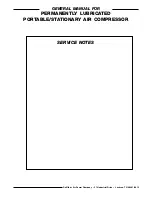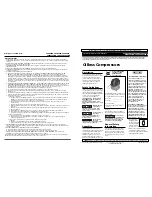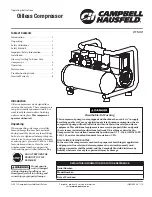
7 — ENG
Location of the Air Compressor
Locate the air compressor in a clean, dry and well ventilated
area. The air filter must be kept clear of obstructions which
could reduce air flow to the air compressor. The air compres-
sor should be located at least 12" away from the wall or other
obstructions that will interfere with the flow of air. The air
compressor head and shroud are designed to allow for proper
cooling. If humidity is high, an air filter can be installed on the
air outlet adapter to remove excessive moisture. Follow the
instructions packaged with the air filter for proper installation.
Air Compressor Anchoring Methods
(Stationary Units Only)
EXCESSIVE VIBRATION CAN WEAKEN THE AIR TANK
AND CAUSE AN EXPLOSION. THE COMPRESSOR
MUST BE PROPERLY MOUNTED AS ILLUSTRATED
BELOW.
Certain air compressor models can be converted
to 240 volts from 120 volt operation. When con-
verting a specific model to 240 volt operation,
the attached three-prong 120 volt plug must be
replaced with the three-prong 240 volt plug (pur-
chase locally) or order line cord Part No. K-0084.
Refer to Parts List of your compressor. Certain
air compressor models can be operated on a 15
amp circuit if:
1.
Voltage supply to circuit is normal.
2.
Circuit is not used to supply any other
electrical needs (lights, appliances, etc.).
3.
Extension cords comply with specifications
in this manual.
4.
Circuit is equipped with a 15 amp circuit
breaker or 15 amp time delay fuse. Use a
Fusetron Type "T" time delay fuse.
INSTALLATION AND BREAK-IN PROCEDURES
Lubrication and Oil
This unit needs no lubrication or oiling.
Extension Cords
To avoid voltage drop, power loss, and overheating to the motor,
use extra air hose instead of an extension cord. Low voltage can
cause damage to the motor.
If an extension cord
must
be used:
• do not use with any permanently mounted air compressor.
• use only a 3-wire extension cord that has a 3-blade
grounding plug and a 3-slot receptacle that will accept
the plug on the extension cord.
• make sure the extension cord is in good condition.
• the extension cord should be no longer than 50 feet.
• the minimum wire size is 12 gauge (AWG). (Wire size
increases as gauge number decreases. 10 AWG and
8 AWG may also be used. DO NOT USE 14 AWG or
16 AWG.)
Some models have a dual voltage motor, 120 and 240 volt. They
are wired for 120 volt but can be converted to 240 volt operation.
Instructions for converting these motors for operation at 240 volt
can be found printed on the label attached to the side of the motor.
If any of the above conditions cannot be met, or if operation of the
compressor repeatedly causes interruption of the power, it may
be necessary to operate it from a 20 amp circuit. It is not
necessary to change the cord set.
Voltage and Circuit Protection
Refer to the specification chart for voltage and circuit protection
requirements of your compressor. Use only a fuse or circuit
breaker that is the same rating as the branch circuit the air
compressor is operated on. If the compressor is connected to a
circuit protected by fuses, use only dual element time delay fuses.
Stationary air compressors must be bolted to the floor.
Bolting holes are provided in the base feet. Mount the air
compressor on a solid, level foundation. Support compres-
sor weight evenly on all four feet. Solid shims may be used
if necessary.
Plastic or PVC pipe is not designed for use with
compressed air. Regardless of its indicated pres-
sure rating, plastic pipe can burst from air pres-
sure. Use only metal pipe for air distribution
lines.
If a pipe line is necessary, use pipe that is the same size as the
air tank outlet. Piping that is too small will restrict the flow of air. If
piping is over 100 feet long, use the next larger size. Bury
underground lines below the frost line and avoid pockets where
condensation can gather and freeze. Apply pressure before
underground lines are covered to make sure all pipe joints are free
of leaks.
It is recommended that a flexible coupling be installed between the
air discharge valve outlet and main air distribution line to allow for
vibration.
Piping

